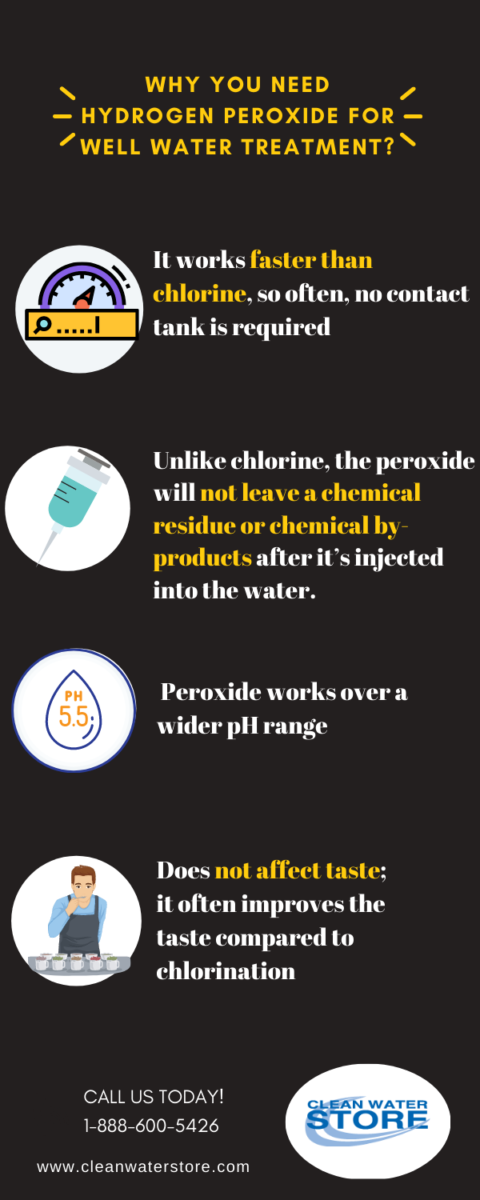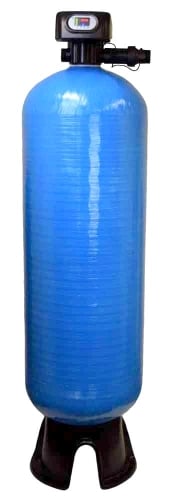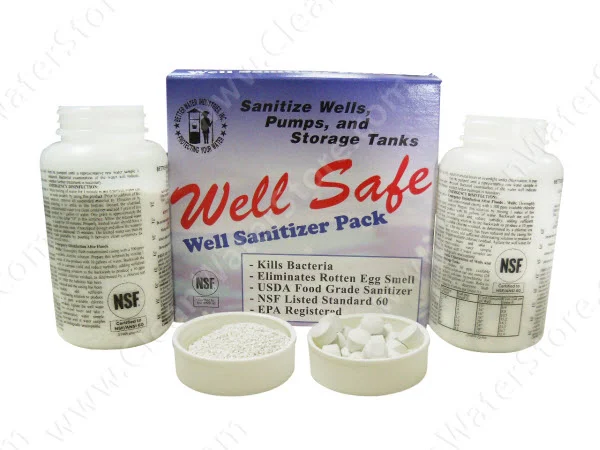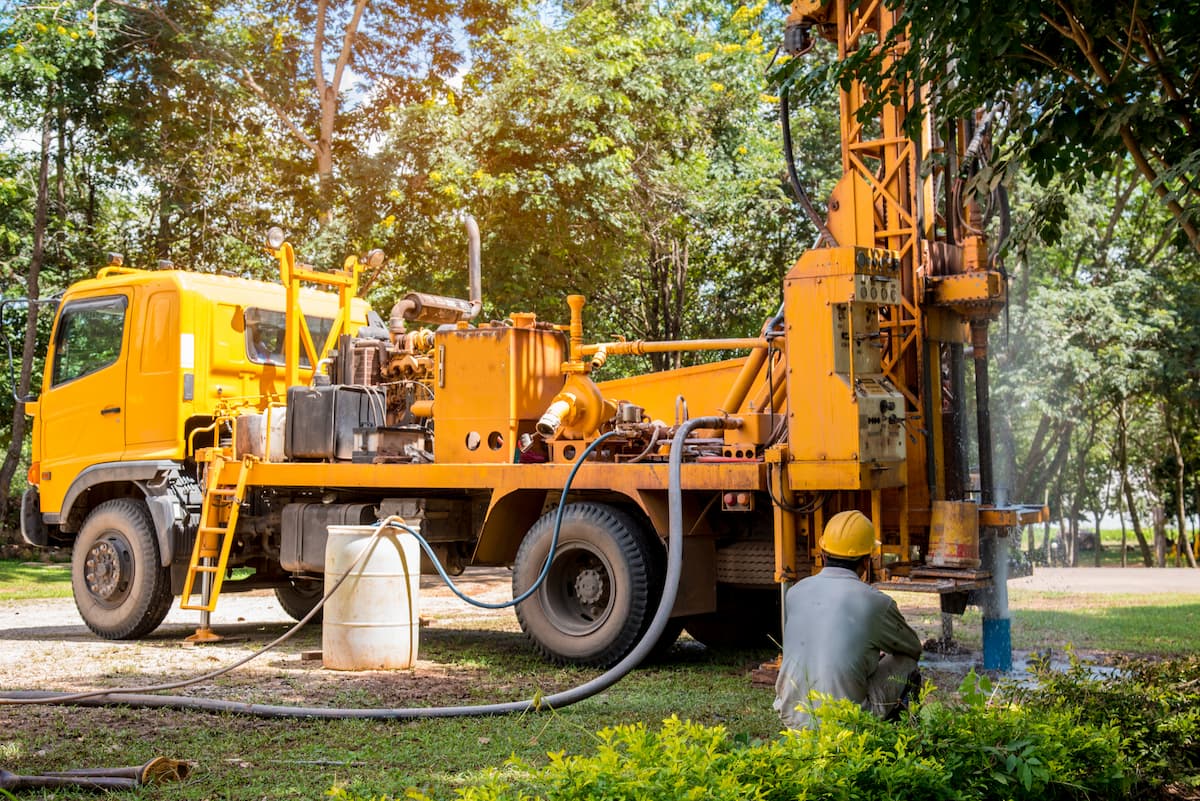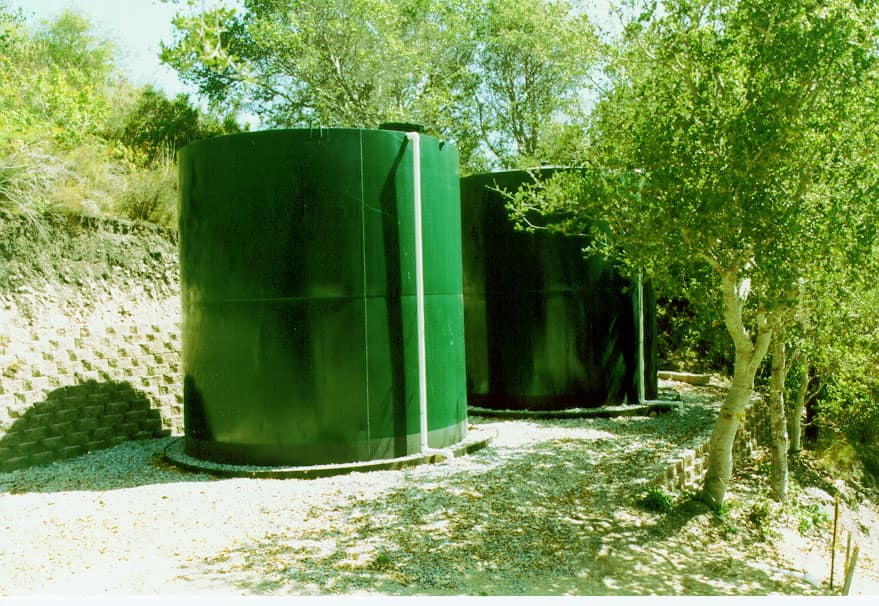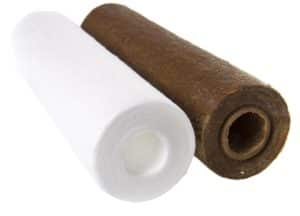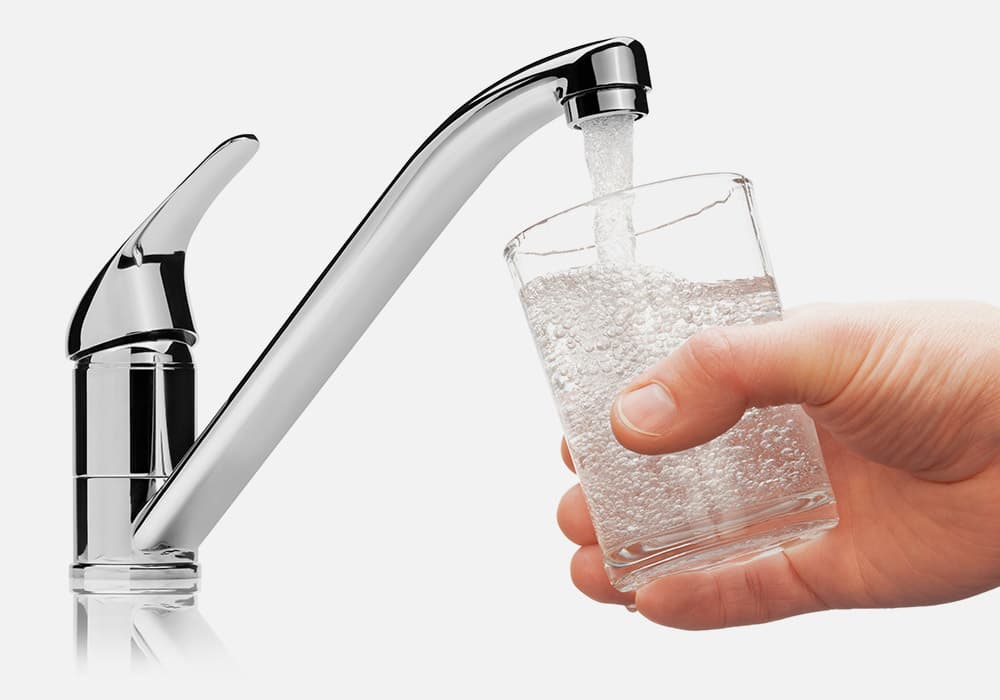Hydrogen Peroxide for Well Water Treatment: How to Eliminate Odors with Peroxide
Podcast: Play in new window | Download
Subscribe: RSS
How to Eliminate Odors and Freshen Well Water with Hydrogen Peroxide
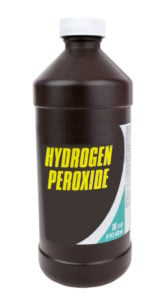
Four years or so ago, I put up a post on our blog called “Eliminate Well Water Odors: Four Reasons Why Hydrogen Peroxide Water Treatment Is Best.” We have had many folks call and email us regarding that article and ask about peroxide systems. I wanted to do a podcast episode explaining it in simple terms: why peroxide can often be the best option to kill sulfur odor in your well water!
Well Water Odor
If your well water smells like rotten eggs, you’re not alone. Well water odor is a common problem. Many homeowners on well water battle the stinky hydrogen sulfide.
Rotten egg hydrogen sulfide-laden water has an objectionable odor, but higher concentrations can be dangerous to health. It’s corrosive to plumbing fixtures and appliances because when hydrogen sulfide is formed and gets into your groundwater, you get sulfuric acid.
That makes the water tarnish fixtures and eat up the pipes. This unique rotten egg odor, hydrogen sulfide, is usually found in hot and cold water and can sometimes be worse in your water heater and hot water.
It can be a problem. It not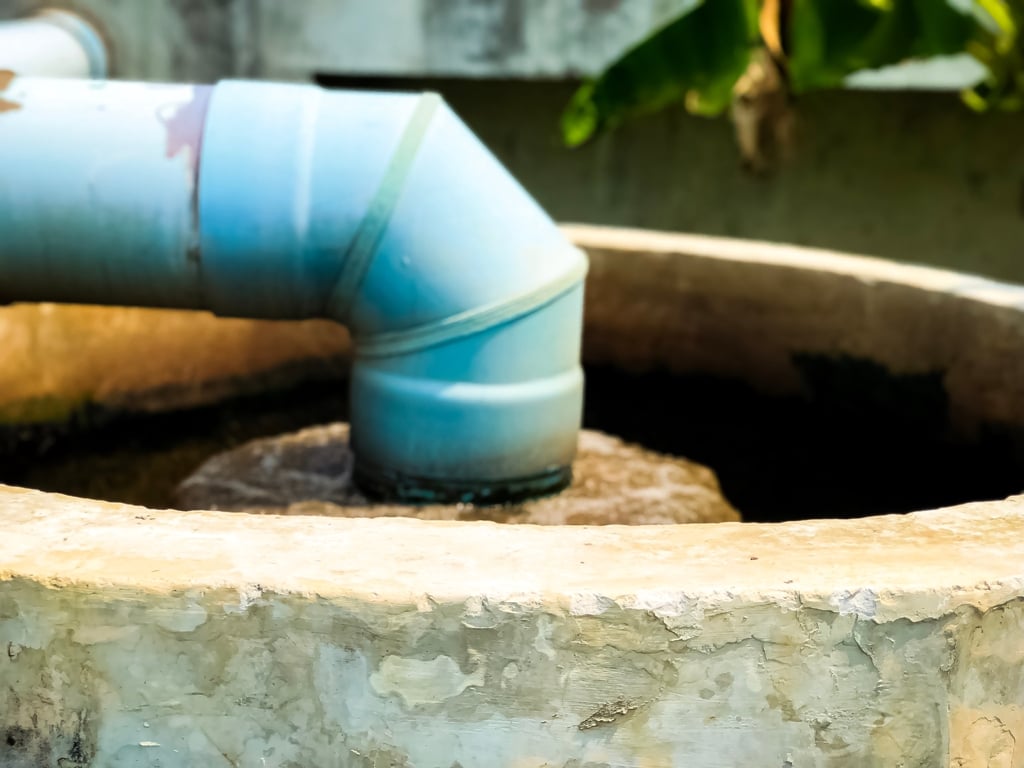
Historically, aeration has been a common way to get rid of smelly water. Chlorine, however, has some undesirable byproducts and can leave chlorine taste and odors if not properly set upright.
Also, if the pH of your water is over 7.5 to 8, in other words, if you have alkaline water, then you have to use a lot of chlorine to get it to kill the hydrogen sulfide rotten egg odor. We found, as a lot of other folks do, we found that hydrogen peroxide does a better job.
Aeration can work well, but if you have iron or sulfur bacteria present, sometimes the bacteria can still create odors after your aeration system. In other words, it can develop in your water heater and plumbing system.
Aeration systems can also be more expensive to set up at times compared to peroxide injection. Peroxide, if you have the right concentration, can kill these iron-sulfur laded bacteria.
So the 4 reasons hydrogen peroxide works:
1. It works faster than chlorine, so often, no contact tank is required
2. Unlike chlorine, the peroxide will not leave a chemical residue or chemical by-products after it’s injected into the water.
3. Peroxide works over a wider pH range
4. Does not affect taste; it often improves the taste compared to chlorination
Over the last 10 years or so, hydrogen peroxide has become a preferred method of treatment for odor by many well water contractors and water treatment specialists all across the U.S. and Canada.
Peroxide and Chlorine
So you might ask: Hey if peroxide is so great, would you ever use chlorination? Well, yes, because chlorine has residual. If you have a chlorine residual, it works better to disinfect your water throughout a distribution system or plumbing system.
That’s why it’s used in communities and municipal systems because you want a chlorine residual to kill bacteria in the pipeline.
Chlorine is cheaper, too, as far as home systems go. Chlorine is less expensive; peroxide can be more expensive. Chlorine has a taste, but you can remove the chlorine taste by activated carbon.
But generally, peroxide is kind of like the deluxe way to go. Usually, it’s better than chlorine when you have a smelly odor problem, and you’re trying to eliminate sulfur and iron-related bacteria in time.
If you have smelly water in your house, you can try to take two-quart jars or large glasses and fill them with your untreated well water. Then, add a teaspoon of household bleach in one and add a tablespoon of 3% store-bought hydrogen peroxide in the other one.
Shake them up and let them sit for a few hours, then smell the water.
You can taste it if you want. It wouldn’t kill you. The one with bleach, you might smell chlorine, but anyway, you’ll find that depending on how much sulfur you have in your water, you might have to add more peroxide or more bleach. You’ll find that the one with peroxide smells and tastes much better than the chlorination one.
 Hydrogen Peroxide For Well Water: How it's set up?
Hydrogen Peroxide For Well Water: How it's set up?
So for big home systems, peroxide is usually set up so that it’s automatically injected into the water before your pressure tank. Most folks will use a backwashing carbon filter after the pressure tank or at the house to filter out any residual peroxide and remove that odor.
With the carbon systems (there’s more information on this on the site), we use what we call catalytic activating carbon. That works really well with peroxide because a catalytic reaction occurs.
If there is peroxide residual in the water along with the hydrogen sulfide, you get a very high level of oxidation occurring right on the carbon itself. After it flows to their home, the result is really clean, odor-free water.
So that’s a simple system. Well turns on, automatically injects peroxide into the pipe before the pressure tank, goes through the carbon filter, and then you have clean water free of odors.
One thing that comes up a lot is contact tanks. In chlorination, we often use contact tanks, like a pressure tank where the water goes in, and you give it some time for the chlorine or peroxide to come in contact with water.
The reaction takes place in this tank over a few minutes. Say if you have 1 or 10 parts per million of hydrogen sulfide and you are just using hydrogen peroxide, you can use hydrogen peroxide without a contact tank and just run it straight into the carbon filter, and the reaction takes place right at the carbon filter and you have clean water without odor.
However, there are some cases where you might want a contact tank. If you have iron or sulfur-laded bacteria, hydrogen peroxide doesn’t kill bacteria instantly.
You’ll need a few minutes for the peroxide, and you’ll need a little higher dose as well, over more than what the hydrosulfide is, to have any effect on the bacteria. That’s why we do often recommend a contact tank, but it’s optional. Some people use it; some people don't.
Different Concentrations
So one thing that comes up is: What strength or concentration of hydrogen peroxide should I use?
This hydrogen peroxide comes in many strengths. Store-bought is 3%. That’s generally safe. The type that we use is, and we can ship safely, and still considered relatively safe, is 7%.
Mainly because it’s safe to handle, it’s not hazardous. You can often find 35% commercial peroxide locally, and it is usually cheaper.
Much cheaper, by the way. However, many people still don’t do it because 35% can be very dangerous to work with.
You have to be very careful. If you spill any, it’s a disaster. Don’t get any on the skin. It’d be a disaster to get it in your eyes. You have to be careful with it. But some people do use it.
Especially if you have a commercial application like for your hog or poultry farms, sometimes it's high flow compared to a home, and it’s much more economical to use the 35%.
But 7% works well. But you know, even 3%, of course, you have to be very careful with it. It’s something you want to keep out of the reach of children. You don’t want it soaking on your skin. Anyway, the concentration we recommend is 7%.
(Click here if you want to read more about Eliminate Odors and Freshen Well Water with Hydrogen Peroxide.)
How to Set up Hydrogen Peroxide for Well Water
I’ll talk a little bit about where the peroxide system is installed. I put some links to the diagrams on the podcast show notes so you can see how it’s set up.
The lowest-cost way, and how most folks do it, is you have a simple metering pump, and it’s wired and set to turn on whenever the well pump turns on.
Your well pump turns on at, say, 30 or 40 psi, and it turns off at 50 or 60 psi. That’s almost how folks have it. They have a single-speed well pump, and when it turns on, you have it set so that the metering pump turns on at the same time. When it turns on, injects a tiny bit of peroxide into the pipe right before the pressure tank.
That way, that water right there is flowing at the same flow rate. So that way, you can easily control the residual that you’re injecting and put in enough peroxide to do the job. You don’t want to put in too much.
So you can easily regulate that and calculate that if you are putting it into a known stream of water. So the injection point is actually an injection check valve.
The metering pump is pumping in the peroxide through the injection check valve. But when the system builds up the pressure and shuts off, no water can come from your pipe into the peroxide pump and solution tank.
So some folks have a variable speed pump or sometimes called a constant pressure pump. These are pretty popular, so if your well pump is that type, you don’t have a traditional large pressure tank but a tiny pressure tank.
Basically, that type of flow system keeps your pressure in your house the same all the time.
Proportional Feed Hydrogen Peroxide System
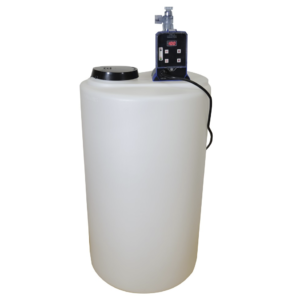
Most folks have a submersible pump, 220 volts. You get the metering pump, and you have it wired into your pressure switch. It's pretty easy to do. You can also have an electrician do it if you don’t know how to do it.
However, that won’t work with a variable speed pump or a constant pressure type of system.
So what do you do? Well, it is very simple, you set up a proportional feed system. All it is is a water meter that you install in the pipe.
In this case, you could put it in the house. You don't have to have it at the well. Basically, what it is, it’s a flow meter.
When water flows through this water meter, it sends out a pulse and turns on your peroxide pump to pump more or less, depending on how fast the water is flowing.
So if somebody is brushing their teeth, that might be a gallon a minute, and someone is taking a shower, might be 5-gallons, and all of a sudden the washing machine is coming on, and all that will affect the flow rate. Whatever the flow rate is, you’ll still have the exact amount of peroxide all the time.
In some ways, those systems are a little safer to use because, although pretty rare, of course, it does happen. You can have a situation where your well pump dies.
So say your well pump is off, but you’re still getting voltage to it, and the peroxide system doesn’t know it, so the peroxide pump is just stuck on and pumps the entire solution tank right into the pipe.
If nobody knows and they turn the well pump back on by accident and start to use the water, you get many peroxides. It’s not likely to happen, but there you go.
So having a proportional feed system can prevent that type of thing and is one more advantage. But those are more expensive, so people are more likely to get the standard one.
Peroxide dissolves the iron.
One question that comes up when discussing hydrogen peroxide for well water is: How about iron removal?
Seems like many folks, a lot of sites, and my local water treatment guys talk about peroxide for iron removal. Well, usually, it does work well for iron too. Peroxide can definitely oxidize the iron.
Iron is often dissolved in the water and may look clear but tastes terrible like rust, and then when it gets exposed to air, or it gets hit with peroxide, it turns to rust.
…but you still need to filter the dissolved iron
So what you can do is use peroxide injection and have that be filtered out by an activated carbon filter or, better yet, an iron filter. That’s usually what we recommend.
If you have high iron levels and use peroxide with carbon, you must have it set pretty carefully.
It has to work just right for it to remove all the iron. And if anything ever happens to peroxide, say you forget to add the peroxide, you can add it, or maybe the peroxide you got is old, then you got iron water running through a carbon filter, and that does not work.
It doesn’t take out much iron. It could flow right through it because you got dissolved iron in the water.
What you need to filter the dissolved iron in your water
In our experience, it’s better to use what we have. We have Pro-OX, a manganese dioxide filter media, but there’s also Filox, Pyrolox, and other different available brands that work well.
We usually do recommend a contact tank with that. Basically, what you’re doing is you’re injecting the peroxide, you’ve got your contact tank where a lot of oxygen is being put in the water, and then the Pro-OX or the manganese dioxide works really well.
Then if something ever happens to the peroxide, the Pro-OX will still work. It just works better with some oxidation like peroxide, or chlorination but it’ll still work on its own, so it’ll give you a break if something ever happens to your system.
However, there are a lot of people that do use peroxide with carbon. It does work, so that’s another way to go. But we don’t really recommend it. If someone has really high iron and odor, and they want to use peroxide, then we recommend a 2-stage system.
The 2-stage filtration has Pro-Ox, and then the carbon filter. That will last for years, and you will have really great water – no peroxide residual in the water, and it’ll clean out all the odors and sediment and work really well.
Will Peroxide kill coliform bacteria?
Another question that we get a lot is, Hey, what about hydrogen peroxide for e-coli? Or how about coliform?
There’s a lot of controversy about this as some water treatment professionals say hydrogen peroxide works great for coliform.
Generally, though, I put a link to this because there are many references to this. Still, hydrogen peroxide itself is rarely used in drinking water or treatment as a stand-alone process.
In other words, hydrogen peroxide is a pretty weak biocide compared to chlorine or ozone. The EPA, for instance, doesn’t recognize hydrogen peroxide for drinking water treatment or as a disinfectant. It can work, but you have to have a very high concentration of it, and it doesn’t last long.
The fact that it doesn't last long is kind of an advantage for residential use. There’s not a chemical residual in it. There are advanced oxidation processes where we use hydrogen peroxide with UV light or inject hydrogen peroxide before ozone.
That produces very high levels of hydroxyl radicals which are really effective at killing bacteria. It also does remove pharmaceuticals or other weird organic compounds, but that usually is not necessary for most homes.
So if you know you got coliform and still want to use hydrogen peroxide, then after filtration, you want to have an ultraviolet sterilizer. At least, that’s my opinion.
You don’t want to rely on hydrogen peroxide alone. In fact, generally, if you have e-coli or coliform (I talked about this in another episode), you want to find out what’s the source of it. Don’t just try to treat it. Find out what’s causing it, and then fix that.
If it’s impossible to fix, let’s say your well is next to a river, and it’s always going to be in the influence of surface water, then you need a very careful type of treatment system that will really deal with that.
Okay, we don't recommend hydrogen peroxide as a disinfectant, although we say it is effective for iron and sulfur-producing bacteria. If health is a factor, like with coliform, we recommend chlorine.
Test to see if the peroxide works
Another thing that comes up a lot is: How can I adjust the peroxide? How do I know it’s working?
These pumps come in different sizes that inject the peroxide, and it depends on how many gallons per minute you’re trying to treat. Here’s the basic overview: What you want to do is you want to inject enough peroxide to overcome the hydrosulfide and interact with any organic bacteria.
When it does that, it’s gone because the peroxide gets used up. So you want to keep injecting enough, so you have a tiny residual, either after the contact tank or, in some cases, right after the carbon filter. You’d be looking at somewhere between .2 and .8 parts per million peroxide.
You don’t want a high level of peroxide in your drinking water. So afterward, you have a very tiny amount, that's good, or you have none, that’s the best.
If you have a contact t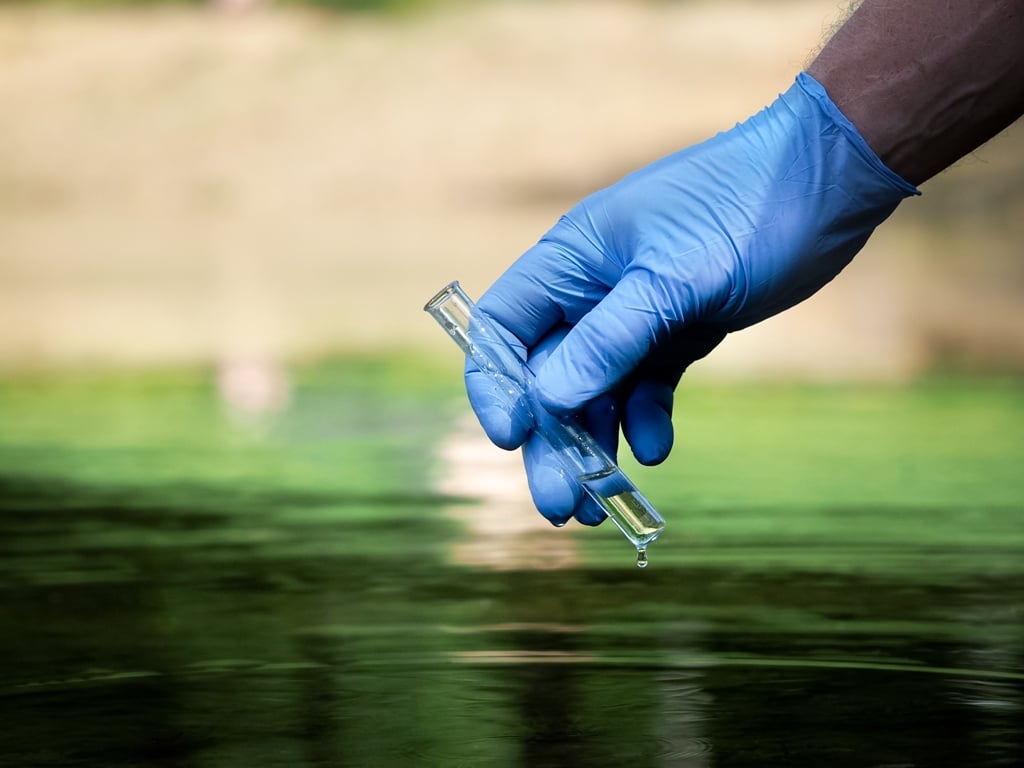
If you don’t have a contact tank, you want enough residual to do the job, but you have very low residual or no residual afterward. Now that sounds kind of too general. There are ways you can actually figure it out with simple test kits.
For example, if you test your water and you estimate you have 5 or 8 parts per million of hydrosulfide and say 1 per million of iron, then you can look at a table and figure out how much hydrogen peroxide to add.
Now I know I need 8 or 10 parts per million of hydrogen peroxide to do the job.
And that’s kind of what you’re looking at. Usually, you inject somewhere between 2 and 10, maybe 15 if you have a high odor level, parts per million of hydrogen peroxide. You can then get a peroxide test strip or test kit, test it in your house or after your treatment system, and make sure you don’t get a high residual because you don’t want to drink water with hydrogen peroxide.
Alright, that about covers it. In this episode, we talked about how great peroxide is for well water odor, how to set up a basic system, when to use the contact tank, and how to test for the peroxide to make sure it’s working.
Thank you for listening, and I hope to talk to you on the next podcast. Hey, if you’re listening to this on iTunes, I really appreciate a rating and an honest review over iTunes.
That helps a lot, and I really like your emails and questions regarding the podcast, so please send an email if you have any questions or comments. My email is [email protected].
If you want to read more about peroxide, go to our site cleanwaterstore.com/blog/podcast and look for episode 12. Thanks to the along with the great links and resources. Have a good day.
Thanks again for listening.

